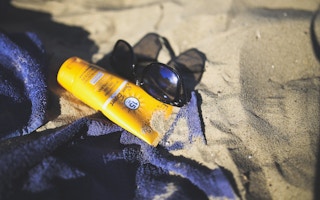An estimated 6,000-14,000 tons of sunscreen are deposited into coral reef areas of the sea every year. The chemicals we rub onto our skin might help prevent skin cancer but we’re only just beginning to understand the environmental impact of sunscreen – and the initial assessments are not looking good.
But early stage research suggests that nature might provide a solution to this emerging problem if we can mimic the way that some plants and animals protect themselves from the sun.
Sunscreen is vital to helping prevent skin damage from ultraviolet radiation (UVR) that can cause melanoma and other skin cancers. They contain a number of ingredients that act as UVR filters, absorbing and scattering the radiation and stopping it from reaching the skin. .
Many studies have demonstrated the benefits of regular sunscreen use, including long-term studies in Australia that have shown reduced skin cancer rates..
The potential problem is that many ingredients used in sunscreen products are synthetic organic molecules, like those used to make plastics. These molecules are designed to be highly stable and so they don’t break down when they enter the environment. As a result, sunscreen ingredients are detectable in species including fish, sea mammals such as dolphins and even marine dwelling birds.
The impact of these molecules on the environment isn’t fully understood but is a growing focus of research. We know that some filters have a similar structure to the hormone oestrogen and mimic can its action. This can cause hormonal changes and even alter the sex characteristics of some fish. UVR filters have also been linked to coral bleaching.
These concerns are being monitored by many regulatory agencies. The European Chemicals Agency has listed eight out of the 16 most commonly used sunscreens in Europe as a potential threat to the environment and health, raising the ultimate possibility of a ban.
Fears about damage to coral reef systems has already led to bans of particular sunscreen ingredients in some coral hotspots such as Hawaii.
These fears are currently relatively minor – but ways to improve the safety and biocompatibility of sunscreens need to be investigated. As is often the way, the answer may lie within the very environment that is being affected. Many marine species are continuously exposed to high levels of UVR throughout the day and have evolved efficient ways to prevent damage.
For example, microorganism species such as cyanobacteria and algae produce a group of compounds called mycosporine-like amino acids (MAA), which act as UVR filters.
“
Many marine species are continuously exposed to high levels of UVR throughout the day and have evolved efficient ways to prevent damage.
These are passed up the food chain to animals such as corals, invertebrates and fish, which then store the compounds in tissues exposed to UVR such as the skin, eyes and eggs. MAA efficiently absorb UVR and convert it to harmless light and heat, and aren’t broken down by the radiation.
There is also evidence that these compounds can act as potent antioxidants, another very beneficial property that most synthetic filters don’t have. Solar radiation can cause highly reactive atoms or molecules, known as free radicals, to break away from other bigger molecules.
Free radicals can cause what is known as oxidative damage to tissues, but they can be neutralised by antioxidants
The potential for these compounds to be applied to human health, particularly as sunscreens, is only just beginning to be explored. They have shown excellent potential in laboratory models. The next step is to translate this to human studies to truly understand their potential.
![]() In the meantime, it’s very important for public health that people don’t stop using synthetic sunscreens. So far, there is only limited evidence for the potential ecological harm of sunscreens, especially at the concentrations at which UVR filters are found in the environment. But the effects of UVR on the skin are well known and proven beyond any doubt.
In the meantime, it’s very important for public health that people don’t stop using synthetic sunscreens. So far, there is only limited evidence for the potential ecological harm of sunscreens, especially at the concentrations at which UVR filters are found in the environment. But the effects of UVR on the skin are well known and proven beyond any doubt.
Karl Lawrence is PhD Candidate in Photobiology, King’s College London and Antony Young is Professor of Experimental Photobiology, King’s College London. This article was originally published on The Conversation.


















